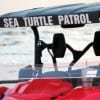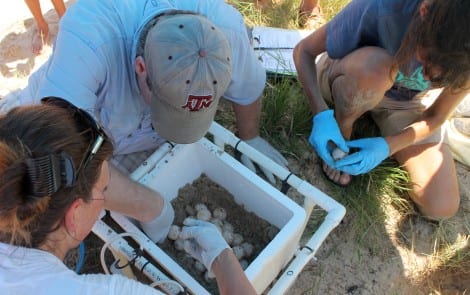 By Theresa Morris
By Theresa Morris
Turtle Island Restoration Network (TIRN) and Texas A&M University at Galveston (TAMUG) have successfully completed another sea turtle nesting season. 72 miles of beach were covered from Rollover Pass, on Bolivar Peninsula, to Surfside Beach on Follet’s Island, including the East and West ends of Galveston Island. With a combination of walking and UTV driven routes, the 220 volunteers and staff were able to patrol each of the 11 routes, 6 days a week from April 1st through July 15th. This season proved tough for the crew, as rough storms, high tides and floods were a constant hazard. It is also believed to have been a deterrent for nesting sea turtles. The species of sea turtle the Upper Texas Coast sees the most is the critically endangered Kemp’s Ridley, which is also the Texas state sea turtle.
This year we had four Kemp’s Ridley nests in Surfside, and 185 nests on the entire Texas Coast. We also had one Loggerhead sea turtle nest in Bolivar, and only six Loggerhead nests in total for the Texas Coast. The last Loggerhead nest seen on our shores was back in 1998. These numbers don’t include the multiple false crawls seen on Bolivar, Galveston and Surfside. False crawls are a sea turtle’s attempt at nesting. If they are interrupted by a disturbance or cannot find a suitable area to dig their nest, they will retreat to the water to try again somewhere else. They will try a few times and if they are completely unsuccessful, can dump their eggs at sea, which is unfortunately lethal for the eggs. Hard, compacted sand, rocks, too many roots, or high tides were issues seen frequently with false crawls this season.
Kemp’s Ridley turtles are the smallest of the sea turtles and lay an average of 100 eggs per nest. When a nest is identified, eggs are excavated and relocated to Padre Island National Seashore for incubation, hatching and release. All information for sea turtle hatchling releases can be found on the Padre Island National Seashore website. Protection of the eggs is necessary for the survival of the species due to the countless predator’s sea turtles face every day. It is estimated that only one in 400 eggs will survive in natural circumstances.

Recovery of eggs from Loggerhead sea turtle nest on Bolivar
Throughout the season, TIRN and TAMUG received support from various organizations and companies, such as US Fish and Wildlife, Texas Parks and Wildlife, National Park Service, Moody Gardens, and NOAA. We all would like to thank Yaga’s, for help with purchasing t-shirts, and The Galvestonian, Palisade Palms, Casa Del Mar and Holiday Inn Seaside Resort for hosting our patrol backpacks and volunteers. The preservation of this species wouldn’t be possible without efforts from all of these organizations. This summer volunteers covered over 15 thousand miles and spent almost three thousand hours on the beach. This is a greater feat than has ever been seen on the Upper Texas Coast and it wouldn’t have been possible without the wonderful support of our volunteers, and our community.
[6-26-2016]

 Posted in
Posted in 

























Guess what? Turtles can’t crawl up the steep dirt piles that the county has bulldozed on the beach (against state regulations). They also need darkness so when the eggs hatch, the babies follow the glow of moonlight into the water.
How many of you property owners will install red or amber lighting on the outside of your home or business? Better yet, which of you will be the first to say, “Don’t pile the dirt in front of my house, I want to keep the shoreline natural so God’s creatures can fulfill their mission as intended”?
Hmmm?? Any brave souls out there?
Remember, the ocean always wins.